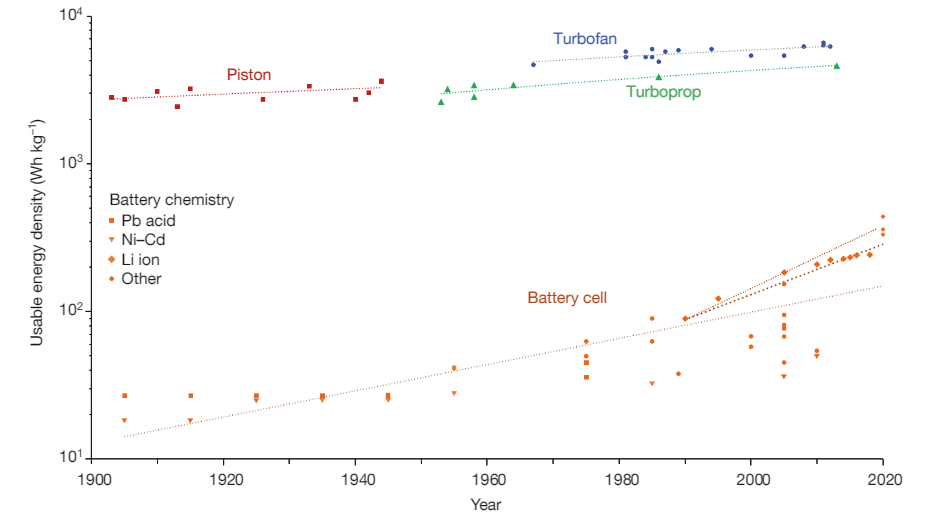When Will I Ride in a Battery-Powered Airplane?
When will I get to ride in a battery-powered electric airplane? It's a question that I think about more often than I care to admit. And I'll give the answer up front.
The future of aircraft - closer to X-Men or closer to Tailspin?
2028. That’s my answer.
In 2028, I will either be able to buy a ticket on an island-hopping commuter plane or save up lots of money to splurge on a ticket for a 100ish mile trip on a 4-8 passenger electric vertical takeoff and landing (eVTOL)-style rotor plane. Some rides on these aircraft types will happen sooner, but for someone who isn’t trying to be the very first person on one of these flights, that’s my guess.
Maybe the better question is - when will a "normal" 2-3 hour flight that covers 500+ miles be a regular occurrence for an airline that exists today? That answer is a lot harder.
The Basics
The process to achieve a new type of flight propulsion in a new aircraft and bringing that aircraft into commercial service involves a number of steps, each of these harder than booking your current flight on your favorite travel site.
1. Proving the technology works
2. Building a prototype and define the concept
3. Executing a first flight
4. Achieving airworthiness
5. Achieving air carrier certificate
6. Selling scheduled flights
7. Executing manufacturing process at scale
8. Proving ongoing profitability
Battery Powered puddle jumpers
Let's work backwards from the 2028 date and island-hopping.
There are companies like Harbour Air and MagniX that have gotten through the first three steps for a modified seaplane with the goal of flying routes around islands in Vancouver.
The technology: A retro-fitted seaplane using a battery driven motor for a propeller plane, the eBeaver. Lithium Ion battery power has been proven to work in cell phones, cars, and other modes of transportation. And it works (just as well? more on that later) for planes.
The prototype: Even in the 1920s, there were battery-powered aircraft in the form of blimps. Today, countless universities and manufacturers have shown that batteries can operate 2-seater aircraft over and over again.
First flight: In 2020, the seaplane mentioned above performed a live 20+ mile flight under battery power. The partners involved are now working on the next generation of aircraft that better integrate battery module design into the structure of the aircraft. Since traditionally fuel is stored in the wings of an airplane, new considerations must be made for making an aircraft with a stable center of gravity and designing the containers that hold the battery cells, the modules, in a shape that makes sense for aviation.
Airworthiness: This is the step that is one of the make or break points for aircraft in this space. Very briefly, airworthiness is going through the process of the FAA approving the design, safety factors, and minimum flight hours for a designated set of standards. MagniX motors have achieved airworthiness with a series of special conditions for propulsion from the FAA.
Air carrier certificate: For airlines that are transitioning to a different aircraft type, updating their air carrier certificate involves updating procedures to include the additional aircraft. For the seaplane team, they will work with Transport Canada to see this process through.
The remaining steps for an existing airline using modified aircraft will remain much the same. Assuming the aircraft price can be factored into the ticket price for a more environmentally sustainable ride, the path to consistent profitability may be long, but customers will likely be willing to pay a premium if the messaging of the airline is clear.
Getting through these hurdles and having aircraft operate on existing island routes should be able to happen within five years, and Harbour Air hopes it happens much sooner.
So now, let's work backwards from the 2028 date and eVTOL-style city hopping.
Image 1: eVTOL Passenger Aircraft Comparison - Number of Passengers and Rotors
Battery Powered eVTOL Options
Here, the 2028 would be for a much more limited offering. The first few steps of achieving novel aviation propulsion are much more uncertain for these types of aircraft.
The technology: Summarizing the technology for eVTOL aircraft could be a series of articles all on their own. There are a few commonalities for the ranges of eVTOLs out there. Power source: most will be powered by some kind of lithium ion battery. These batteries will replace combustion as the power source, driving propellers or induction fans depending on the vehicle. I will leave other alternative fuel sources (hydrogen fuel cells, sustainable aviation fuel) out of this writeup.
Most eVTOLs that have accomplished their first flight use four or more rotors so that they have enough power to transition from vertical to horizontal flight. In addition, the greater number of rotors provides redundancy as well as greater control over the noise profile of the aircraft. See Image 1 for an overview of some of the main players, comparing their number of rotors and target number of passengers.
The prototype and first flight: The number of eVTOL prototypes seen at trade shows or in computer renderings is staggering. Companies from Mercedes to Amazon have considered vehicles in this space. For this article, I'm limiting vehicles considered to those that can have at least one pilot and room for passengers. Based on the pace of regulations in the aviation industry, while pilotless passenger vehicles are possible, the regulatory concerns will be significant.
Airworthiness: this is the step where most eVTOL efforts are stuck. Not only do these companies need to prove their aircraft are airworthy, the standards to which they are aligning have shifted. As of July 6, 2022, the FAA shifted the regulatory path from existing small airplane (14 CFR Part 23) regulations to a special class of powered lift aircraft (21.17(b)), affecting companies like Joby and others. The path to airworthiness involves three sequential phases, although to achieve their target first commercial operations in 2026, companies are preparing for each phase in parallel. That speeds the process but also creates risk if the regulatory path shifts again or technologies change.
Air carrier certificate: Many of the same uncertainties exist for air carrier certification as for airworthiness - the path is not certain and the companies trying to follow the path have not been certified air carriers before. Some of this risk is reduced with strategic legacy airline partnerships in place (United has a partnership with Archer and ANA, a Japanese airline, is a partner of Joby). Yet, even airlines operating traditional aircraft take several years to pass this step. As an air carrier, you must have a procedure for everything, from boarding and safety briefings to engine out procedures. Although the path is possible, it will be a long one depending on the country of operation.
Selling scheduled flights, manufacturing at scale and becoming profitable: Now for the easy part? Depending on your perspective, once tickets can be sold, busy travelers will pay high amounts to fly from busy city centers to other places to avoid ground traffic. Think of having access to your own private helicopter whenever you want it. How much that service will cost and what people will be willing to pay for it is still anyone's best guess. However, based on the level of investment, there's enough funding to see a few winners through.
Image 2: eVTOL Passenger Aircraft Comparison - Range and Speed
Battery operated 100+ seat airliners
When I set out to write this, I was hoping to be surprised that the reason most battery powered passenger aircraft were in the 4-10 passenger range was just a lack of foresight and maybe a lack of funding. But - well, there's a reason these concepts aren't out there. The power generation options just aren't there (yet). Viswanath et al and a Wired article do a great job summarizing the energy density needs of traditional airliner-sized aircraft as seen in Image 3. The paper also walks through the unique challenges of operating airliner-sized planes: the need to operate at extreme temperatures, the need to recharge quickly, the need to last for thousands of recharge cycles and a few others.
Image 3: Energy Density by Battery Chemistry and Aircraft Type
The technology: So - is all hope lost? Can't we just jam more batteries in a bat-wing shaped aircraft and call it a day? Well, yes and no. Personally I have hope that like semi conductors followed Moore's law of computing power increasing exponentially, the recent attention in massive production scales for batteries needed by electric cars will lead to ever-increasing battery capabilities. The added attention, large economies of scale and improved mining techniques could result in some magical progress. However, magic is not science. There still needs to be close to an order of magnitude-level breakthrough to have a battery powered 200 passenger 3000 mile flight. Images 3 and 4 show that such a flight requires almost five times the energy density achieved by today's electric cars. This energy density can be measured in watt hours per kilogram (Wh/kg). Current cars achieve close to 400Wh/kg while top end 200+ passenger aircraft will require upwards of 2000 Wh/kg.
There is a lot of space, though, between the eVTOLs mentioned above and a large airliner. At double the current electric car battery energy density, regional passenger flights are possible. With advances in cathode capabilities and anode chemical replacements, I think that goal is within reach. It definitely will be close to 2038 than 2028, but I think the environmental need is there - although more than 50% of aviation emissions come from 200+ passenger flights, that is still upwards of 40% of air traffic emissions that can be reduced. Paired with the fact that 48 % of flights are 500 miles or less, if the maintenance of battery operated airliners can be much less than it is today, than that is the path to your battery operated airline.
By 2030, you'll be able to seek out a ride on a battery powered plane, and if you're willing to pay 3x the price, you can probably pull that forward a few years.
But oh how I would love to be proven wrong. 2028 is my answer. How far the flight goes, how much it costs, and how many of your friends you can bring along are the real questions.
Image 4: Passenger Load Compared to Energy Density





